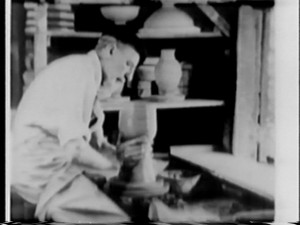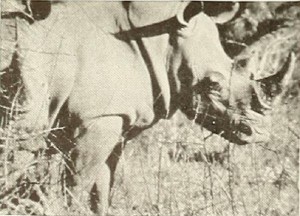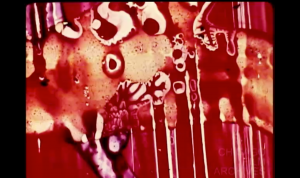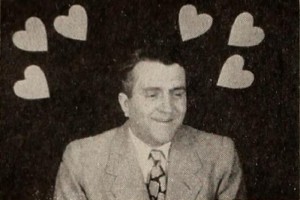"doc. didattico"/educational documentary

"Ceramics, by Kenneth V. Bloomer, ACL, and Elizabeth Sansom, ACL, is probably the most ambitious amateur film ever attempted on this particular subject and perhaps stands alone in its field. The makers of the film were fortunate in having the cooperation of a famous ceramic artist, Leon Volkmar, who maintains his atelier at Bedford Village, N. Y. It was here that the entire film was produced, its makers having imbibed the spirit of the artist craftsmen so thoroughly that every deft touch, every careful step in the process of making a lovely vase are recorded. The interior lighting and closeup technique are especially good, particularly in those parts where only the delicate focusing of a closeup will reveal the nuances of the artist's touch as he models. The sequences which show the firing of the pottery are unusually well handled and the whole is outstanding in its clarity of continuity. Such a film might be described as a "glorified industrial" but, more than that, it is an educational film in the best sense of the word." Movie Makers, Dec. 1933, 499-500.

"In the tradition of Carl Akeley and the late Martin Johnson is the humorously titled but essentially serious film, Charlie, the Zulu Game Guard, by Esther and Vincent Vermooten. Stalking rhinos, both black and white, in the Hluhluwe Reserve of British South Africa, Dr. and Mrs. Vermooten, accompanied by the game guard Charlie, managed to capture on film a series of incomparable studies of the beasts in their native habitat. The circumstances must have been difficult, the pursuit undoubtedly dangerous, but Dr. Vermooten used a tripod throughout and succeeded, despite obvious trials of climate and heat, in getting perfect color rendition. This fact, added to the well planned continuity of the film, makes it an outstanding accomplishment of its kind." Movie Makers, Dec. 1940, 602.
"The relatively short photoplay, Choosing a Scenario, has been awarded Honorable Mention because it is a smooth and superficially brilliant example of comedy film story making. Originally produced as one of the entries in a group filming contest conducted by the Cinema Club of San Francisco, the picture took first award in that contest for its director, William Palmer. ACL, its cameraman, K. G. Stephens. ACL, and its lone actor, J. Oliver Tucker, ACL. Although comparatively slight in significance, it offers fine photography, intelligent cutting, effective angles and deft acting in telling a clever story with lively tempo." Movie Makers, Dec. 1935, 551.
"Christmas Nuts, presented with a sound on film recording on a separate 16mm. film, produced by Paul Braun and Howard Goodman, is not only an interior color picture of exceptional beauty and impeccable technical quality but is also one of the best puppet films thus far created. With a camera technique paralleling that of the latest theatrical, animated talkie cartoons, the story of a wolf "hijacking" Santa Claus and the consequent near calamity for the two squirrels is unfolded in a completely cinematic fashion. The camera moves freely from medium shot to closeup, the mechanics of the sets are not obstrusive and the puppets move with agility and grace. The sets, which were designed and constructed with great care, are very handsome and exquisitely finished so that no imperfections are revealed in the enlarged picture of them on the screen. The sets, in combination with the colored lights used in part to illuminate them, embody the producers' theory of "created color." That is, no attempt is made to simulate nature, but rather to produce pleasing, vivid color combinations, as in the illustrations of a child's story book. A cleverly compiled dialog, song and music accompaniment has been synchronized with the picture, although recorded, at present, on a separate film." Movie Makers, Dec. 1935, 534.
"A combination of time lapse cinemicrography and shooting huge factory interiors presented William Schanzenbach, ACL, with the gamut of technical difficulties in the photography of the four reel picture, The Commercial Production of Yeast. The interior shots of huge tanks and other machinery were not only adequately exposed but also were shot from attractive angles without extreme consciousness of camera angles. The laboratory sequences, in which time lapse technique was combined with work at the microscope to show the growth of yeast over a period of time, were well handled. Careful planning and clear titles add to the virtues of this exceptional industrial film." Movie Makers, Dec. 1935, 551.

"An amateur experimental film made by Sol Falon and distributed by the Society of Amateur Cinematographers (SAC)." Chicago Film Archives
"Design, by Walter Mills, ACL, is an expository film study on 8mm. and shows to fine advantages the possibilities of this medium for serious cinematic undertakings. In this 200 foot reel, the story of a day at the Kendall Art School, in Grand Rapids, Mich., has been told coherently and instructively. The picture represents real skill in planning, selection of viewpoint and photography. Naturally, most of the sequences in the film called for interior shots and the maker is to be commended highly for his lighting arrangements, which give perfectly normal effects in the film without the usual glare and unevenness. Angle shots and unusual camera positions are used with restraint but with most happy results when the situation calls for them. The technical quality is of uniform excellence and the cutting is done with particular care." Movie Makers, Dec. 1933, 522.

"Staria Zimmerman, that charming Milwaukee minx who made her big time bow in The Boss Comes to Dinner, a 1944 Ten Best winner, has done it again in The Dizzy Top. As the impish daughter of a winsome but widowed mother, she pulls the strings in this "merryonette" show which maneuver her pretty parent into the arms of a new and handsome husband. The quite willing victim of these arch designs is, in the film, the proprietor of a swank hat shop, and it is in this bright locale that the majority of the action takes place. Patricia and Ryne Zimmerman — the producers and supporting players — have a sharp and genuine sense of farce comedy. Their lighthearted plot dances forward as gaily as the suave settings they have contrived for it. Their incidents are antic in their absurdity, their timing crisp and delicately controlled. These qualities are, to be sure, aided immeasurably by Mistress Staria, who carries off each new comic conceit with impudent but charming assurance. Mr. Zimmerman's technical execution in their latest film leaves little to be desired in competence and imagination. There is, to a heightened degree, the same warmth and brilliance in his lighting which marked The Boss. His camera viewpoints are effective and varied, cutting one into the next with precision and pace. Show pieces of cinematic imagination enrich the production, like sugar plums in a Christmas pudding. The Dizzy Top, the Zimmerman's first 16mm. effort, is a handsome step forward along their chosen course of lighthearted comedy." Movie Makers, Dec. 1946, 486.
Total Pages: 14